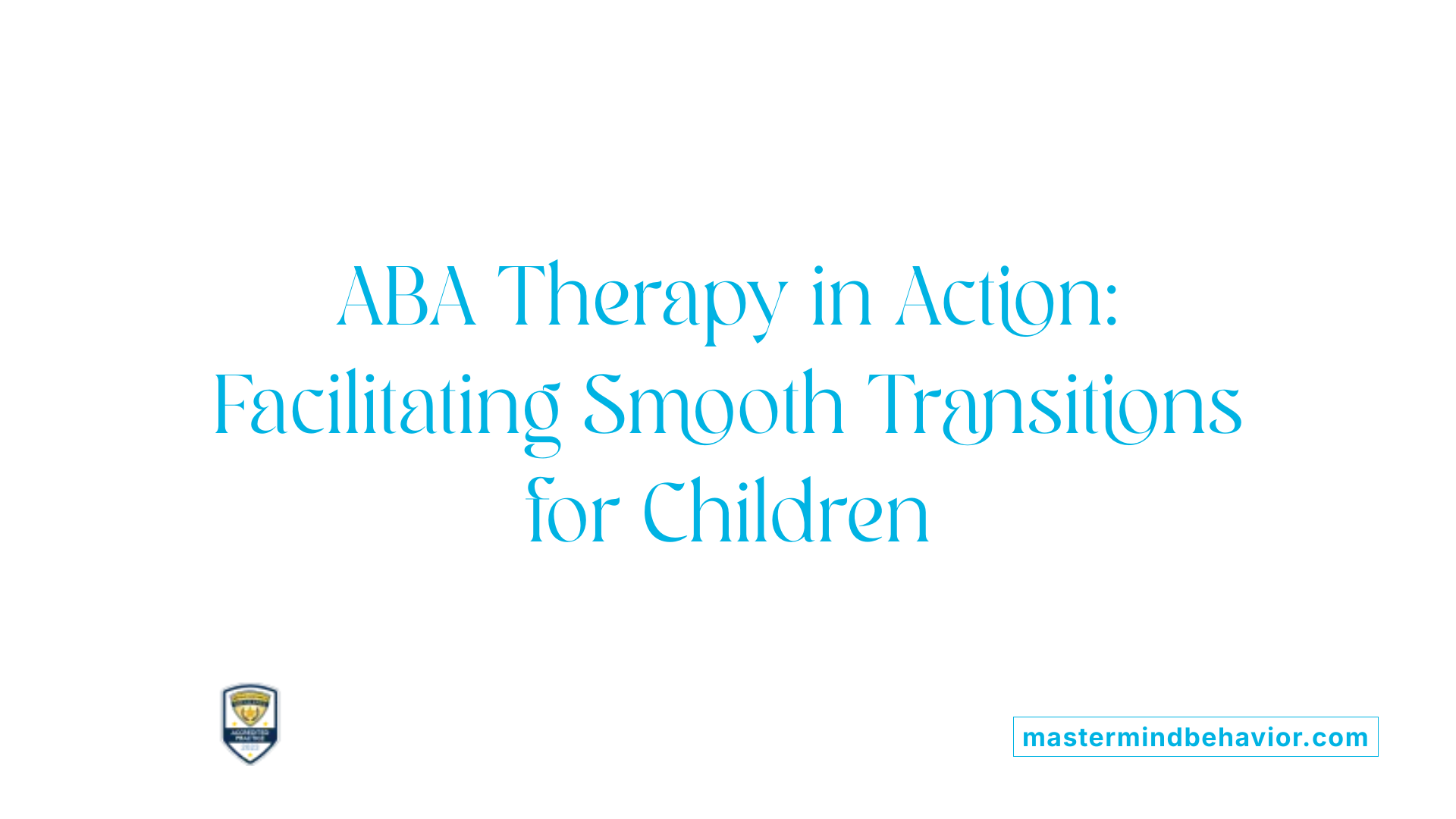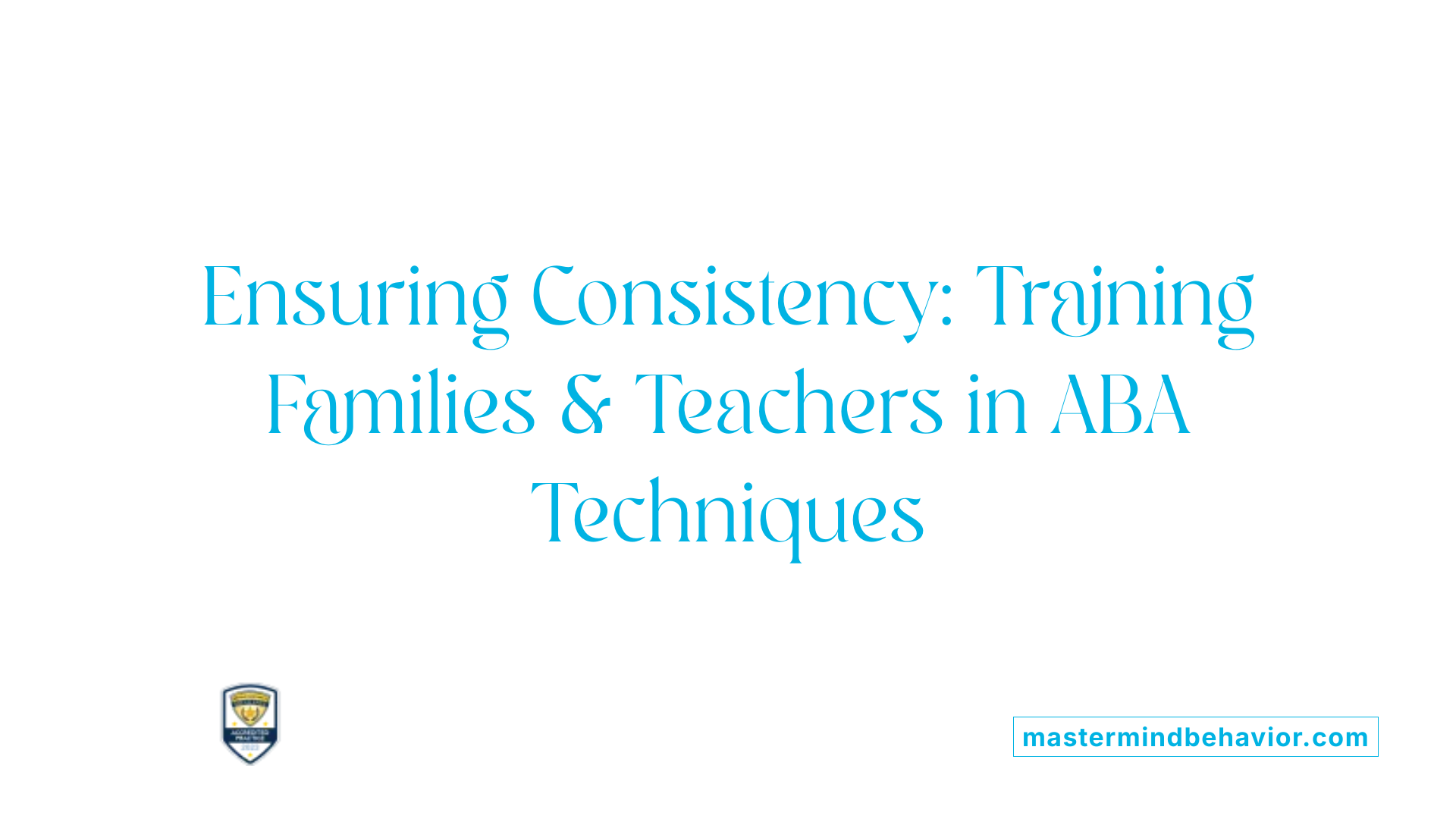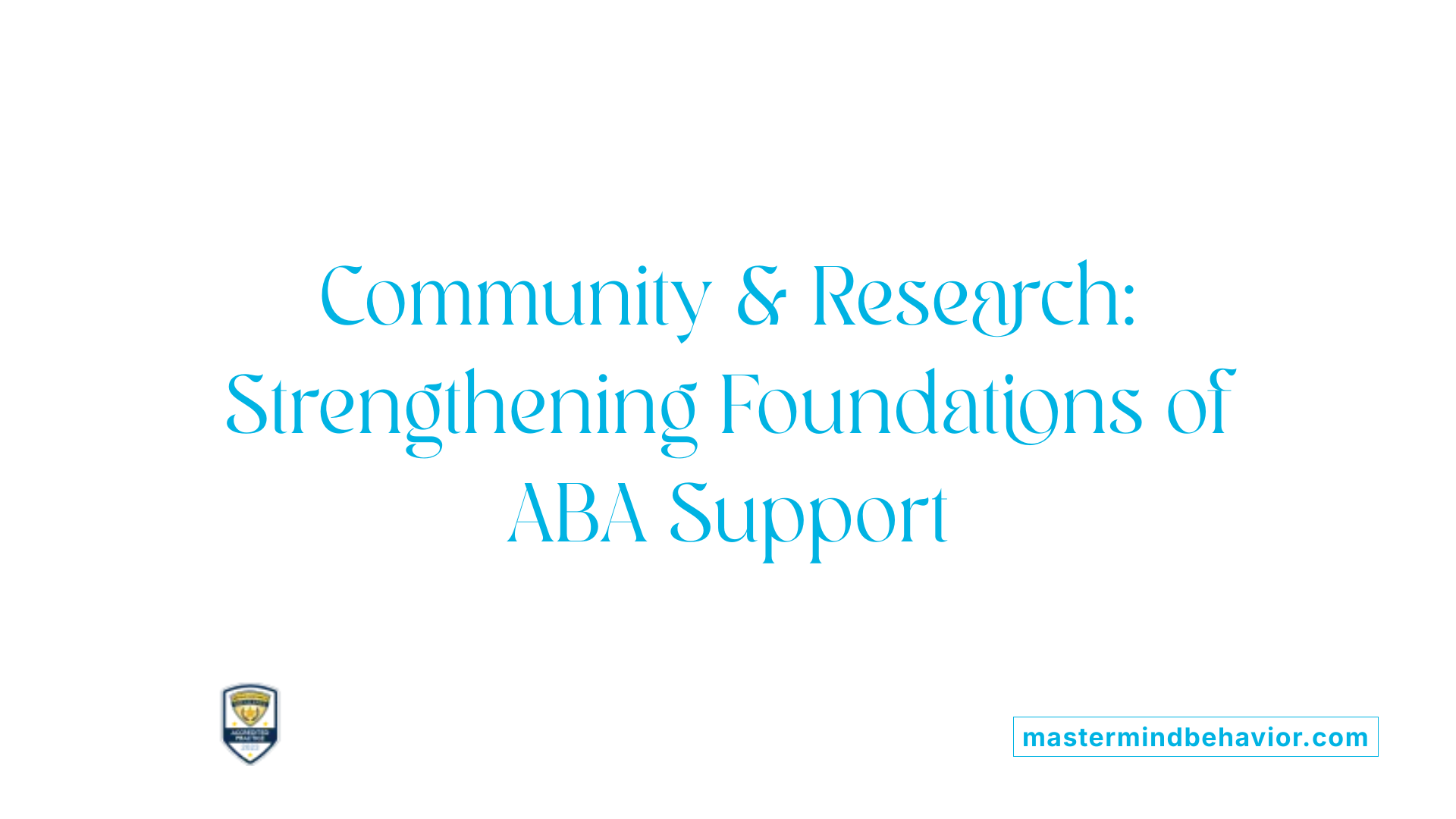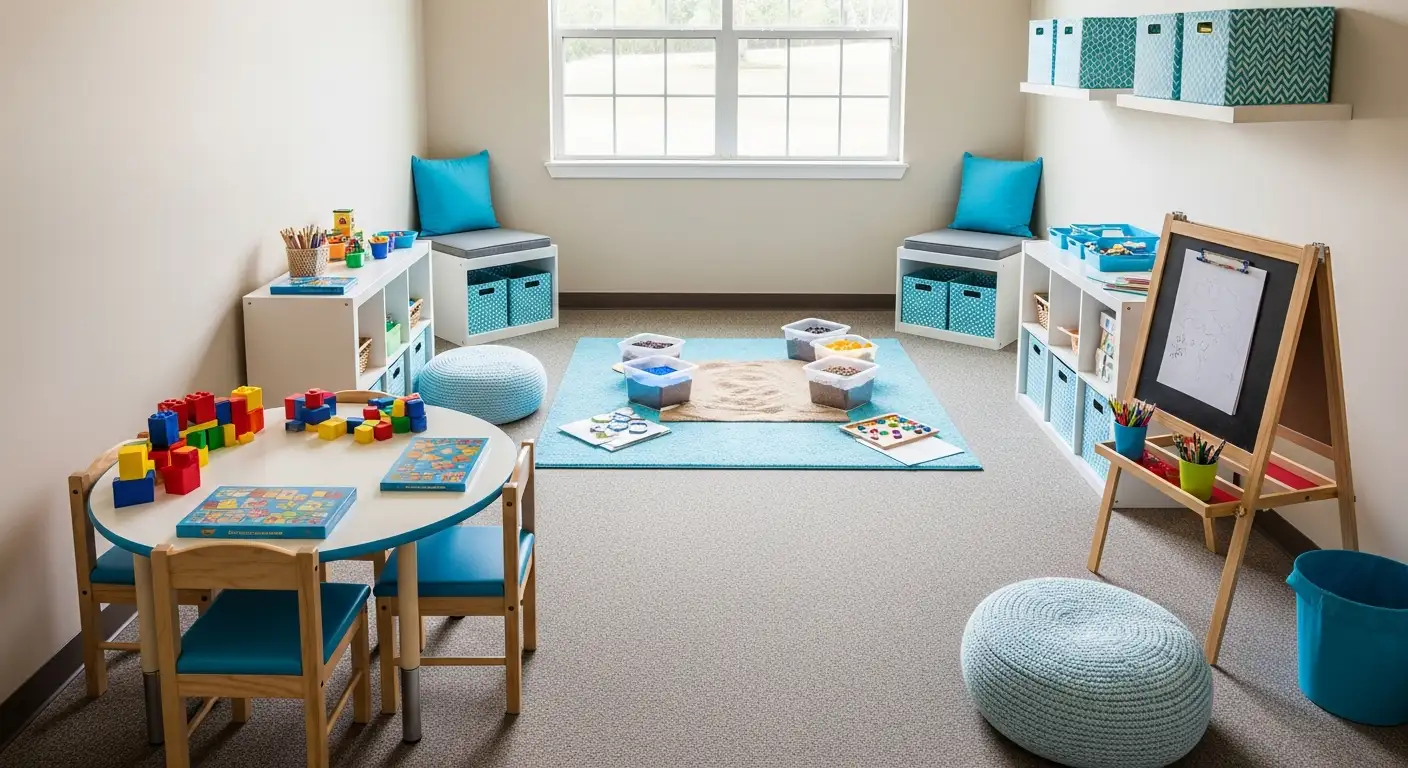How ABA Therapy Improves Transitions Between School Activities

Understanding the Significance of Smooth Transitions in Education
Transitions between school activities can be stressful and challenging, particularly for students with autism spectrum disorder (ASD). Effective strategies that facilitate these movements not only improve behavior but also promote independence and confidence. Applied Behavior Analysis (ABA) therapy emerges as a powerful tool in supporting students through these crucial moments, ensuring they navigate their school day more smoothly and with less anxiety.
The Role of ABA Therapy in Supporting Transitions
 How does ABA therapy facilitate smoother transitions between activities in educational settings?
How does ABA therapy facilitate smoother transitions between activities in educational settings?
ABA therapy helps individuals move more easily from one activity to another at school by teaching essential skills through reward-based learning. Therapists create personalized plans that break down transition steps into small, manageable parts. This allows the individual to practice and develop confidence over time. Data collection tools and progress assessments help therapists adjust strategies for maximum effectiveness.
Caregivers and family members are also included in training programs so that these skills are reinforced at home and in other settings. This consistency helps individuals transfer what they learn in therapy to everyday life, making transitions less stressful.
In summary, ABA uses systematic teaching techniques to develop communication, adaptive behaviors, and self-control, all of which support smoother transitions and reduce behavioral challenges in schools.
What specific techniques are used in ABA therapy to support transitions?
ABA therapy employs several practical methods to support changing activities smoothly. Visual tools such as schedules, transition cards, and social stories help prepare individuals by giving a clear picture of what to expect. These reduce anxiety and resistance during changes.
Other proactive strategies include countdown timers, visual timers, and practice opportunities. Therapists may also incorporate choices and fun activities like songs or games to make transitions more engaging. Role-playing and gradual exposure help individuals become comfortable with upcoming changes, strengthening their independence.
In addition, teaching functional communication skills and providing calming tools can help manage self-regulation and ensure more confident, stress-free transitions.
Benefits of ABA in Enhancing Transition Success
 Applied Behavior Analysis (ABA) plays a significant role in helping students with autism navigate changes in their daily routines and environments smoothly. One of the primary advantages of ABA is its ability to boost confidence, independence, and emotional resilience in learners. By using visual supports like schedules and social stories, ABA helps children understand what to expect, which can reduce anxiety related to transitions.
Applied Behavior Analysis (ABA) plays a significant role in helping students with autism navigate changes in their daily routines and environments smoothly. One of the primary advantages of ABA is its ability to boost confidence, independence, and emotional resilience in learners. By using visual supports like schedules and social stories, ABA helps children understand what to expect, which can reduce anxiety related to transitions.
ABA also emphasizes the development of practical life skills and social behaviors, making it easier for students to adapt to new activities or settings. Techniques such as task analysis break down complex actions into manageable steps, while positive reinforcement encourages repeated success, fostering a sense of achievement.
Collaboration is essential for effective transition support. Therapists, educators, and families work together to create consistent strategies, ensuring that the child receives reinforcement and guidance across different environments. This teamwork helps reinforce learned skills and promotes emotional resilience, making transitions less stressful.
How ABA improves confidence, independence, and emotional resilience
- Creates predictable routines and visual supports.
- Teaches coping skills and self-regulation strategies.
- Reinforces success to build confidence.
- Develops practical skills for daily life.
The role of collaborative strategies among therapists, educators, and families
- Ensures consistent application of transition strategies.
- Shares progress and adjusts interventions as needed.
- Supports emotional well-being across environments.
- Facilitates smoother, more successful transitions for students.
Using Visual Supports and Social Stories
 Visual supports and social stories are essential tools in supporting children on the autism spectrum, especially during periods of change or transition. These tools help children understand what to expect, reducing feelings of uncertainty and anxiety.
Visual supports and social stories are essential tools in supporting children on the autism spectrum, especially during periods of change or transition. These tools help children understand what to expect, reducing feelings of uncertainty and anxiety.
Visual supports include visual schedules, transition cards, and picture cues. These tools provide a clear visual representation of upcoming activities or routines, making it easier for children to anticipate and prepare for changes. This visual information helps children feel more in control and reduces behavioral challenges caused by confusion or fear.
Social stories are narrated scenarios that explain specific social situations, including transitions. They describe what will happen, what is expected, and appropriate behaviors in a calm and simple way. By reading or reviewing these stories, children gain confidence and learn how to navigate new routines smoothly.
When used consistently across different settings, visual supports and social stories promote skill generalization and foster independence. They serve as a calming anchor for children, making transitions less intimidating and more manageable, which ultimately supports successful engagement with daily routines.
| Tool Type | Purpose | Benefits | Examples |
|---|---|---|---|
| Visual Supports | Clarify routines and activities | Reduce anxiety, improve understanding | Visual schedules, pictorial cues |
| Social Stories | Prepare children for specific situations | Explain social expectations, foster confidence | Stories about transitions or social rules |
Training Families and Educators for Consistency

The importance of caregiver and teacher involvement
Engaging families and educators is essential in supporting autistic individuals, especially during changes in activities or routines. When both groups are well-informed and trained, they can create a consistent environment that promotes learning and emotional regulation. This consistency helps reduce anxiety and behavioral challenges associated with transitions, making the experience smoother for autistic learners.
Strategies for training and reinforcement outside therapy sessions
Effective training for families and teachers involves teaching them specific strategies to reinforce positive behaviors outside of formal therapy. This includes using visual schedules, social stories, and clear, predictable routines. Positive reinforcement, such as praise or rewards, is crucial in encouraging desired behaviors during activity changes.
Additionally, collaboration between therapists, families, and teachers ensures everyone applies similar techniques, which reinforces learning and stability at home and school. Consistent communication helps adapt strategies as needed and increases the likelihood of success.
How does ABA therapy assist students during activity changes?
Applied Behavior Analysis (ABA) therapy plays a significant role in helping students navigate activity transitions. It offers structured support by creating predictable routines tailored to each individual. This approach builds a sense of security and prepares students for changes ahead.
ABA therapy teaches coping skills and self-regulation strategies, empowering students to manage their emotions during transitions. Therapists break down complex behaviors into manageable steps, making it easier for students to adapt. Positive reinforcement rewards successful management of activity changes, encouraging the development of lasting skills.
Furthermore, collaboration with families and educators ensures that consistent practices are maintained across settings, reinforcing progress and easing transitions.
Research and Community Support in ABA

Why are community support and research important in autism care?
Community involvement is vital for creating an inclusive environment that supports individuals with autism. Support networks provide emotional encouragement, shared resources, and practical assistance, which can significantly improve life experiences. Research advances help identify effective interventions and inform policies that benefit autistic individuals throughout their lives.
Organizations like Autism Speaks champion these efforts by facilitating awareness campaigns and promoting scientific studies. Such initiatives aim to enhance understanding, acceptance, and tailored interventions for those on the autism spectrum.
How does advocacy work to increase access to ABA therapy?
Advocacy is crucial for expanding access to evidence-based treatments like Applied Behavior Analysis (ABA). Autism Speaks actively pushes for policy changes that prioritize funding and insurance coverage for ABA therapy. They aim to make these services more affordable and widely available, recognizing their importance in supporting behavioral, social, and emotional development.
Through lobbying, public awareness campaigns, and partnerships with policymakers, organizations strive to eliminate barriers that prevent autistic individuals from receiving timely and effective treatment.
What are the benefits of ABA therapy in improving transitions for students?
ABA therapy provides vital tools for improving transitions, which can be challenging for students with autism. Visual supports like schedules and social stories prepare students for upcoming changes, reducing anxiety and increasing predictability. Techniques such as task analysis and positive reinforcement build independence and confidence.
Further, ABA focuses on developing life skills and social competencies, making it easier for students to adapt to new environments such as school, work, and community settings. Collaboration among therapists, teachers, and families ensures consistent strategies, helping students manage transitions more successfully.
| Aspect | Description | Benefits |
|---|---|---|
| Visual Supports | Use of visual schedules, social stories | Reduce anxiety and prepare children for change |
| Techniques | Task analysis, positive reinforcement, rehearsals | Build independence and behavioral flexibility |
| Goal | Enhance social and practical skills | Facilitates smoother adjustments across settings |
| Collaboration | Involvement of therapists, educators, families | Ensures consistent and supportive strategies |
In conclusion, community engagement combined with research-backed interventions like ABA plays a fundamental role in improving the quality of life and transition experiences for individuals on the autism spectrum.
The Broader Impact of ABA Therapy on Children's Success
Applied Behavior Analysis (ABA) therapy plays a significant role in supporting children with autism by improving their skills across various areas. One of its primary goals is to help children develop confidence, independence, and social skills, which are critical for their overall development.
ABA therapy employs structured techniques such as visual cues, routines, and turn-based activities to make transitions less stressful. These methods teach children functional communication skills like understanding directions and emotional vocabulary. When children learn to communicate effectively, it reduces frustration and behaviors like tantrums or aggression, especially during change.
During transitions—such as moving from home to school or between activities—ABA therapy fosters smoother adjustments. It rewards positive behaviors and compliance, motivating children to adapt more easily. Therapists work closely with families and educators to ensure these strategies are consistent across different environments, promoting skill generalization.
Long-term benefits of ABA therapy extend beyond immediate behavioral improvements. They support better educational experiences and community participation, helping children become more integrated and autonomous. For example, children gain the social skills needed for peer interactions and self-regulation, setting a foundation for successful lifelong learning.
| Aspect | How ABA Supports Children | Long-term Benefits |
|---|---|---|
| Communication skills | Teaches understanding directions and emotional language | Better social interactions and emotional resilience |
| Behavioral adjustments | Uses reinforcement to encourage positive change during transitions | Increased independence in daily routines |
| Sensory and social skills | Addresses sensitivities and builds social confidence | Improved community participation |
| Support network | Collaboration with families and educators ensures consistent learning | Successful integration into school and community |
By focusing on these areas, ABA therapy significantly enhances a child's ability to succeed in various aspects of life, from educational settings to broader community involvement.
Conclusion: Promoting a Smooth Transition with ABA
Applied Behavior Analysis (ABA) plays a significant role in supporting autistic individuals through various life transitions. By focusing on tailored strategies, ABA helps improve skills needed for school, work, and social integration, making these changes smoother and more manageable.
A collaborative and personalized approach is essential. Recognizing each person's unique needs and goals ensures that ABA techniques are effective and respectful. Working closely with families, educators, and therapists creates a supportive environment focused on individual success.
Implementing ABA methods during transitional periods encourages greater independence and confidence. Embracing these techniques, with proper guidance, can greatly enhance quality of life for autistic individuals and help them thrive in new settings.
Fostering Success During Transitions
In summary, ABA therapy plays a pivotal role in improving transitions between school activities by teaching essential skills, utilizing effective supports, and fostering collaboration among families, educators, and therapists. Its evidence-based techniques empower students to navigate changes with confidence, reducing anxiety and behavioral issues. Prioritizing individualized and consistent strategies, ABA ensures that students develop the independence and resilience needed for successful participation in educational and community settings. Embracing these approaches can significantly enhance the overall school experience for children with autism and other special needs, laying a strong foundation for future success.
References
- Autism Speaks: Autism support, resources & advocacy
- Reducing Challenging Behaviors during Transitions
- How ABA Therapy Can Benefit Children with Autism
- Preparing for Back-to-School: How ABA Therapy Can Ease ...
- Transitions: 4 Tips to Prevent Meltdowns
- Helping Kids Transition Successfully in ABA Therapy
- Transition Time: Helping Individuals on the Autism Spectrum ...
- Autism Transition Strategies: 5 Steps to Smoother Transitions
- ABA Therapy Techniques to Help Your Child Handle Change
Recent articles

How ABA Therapy Improves Morning And Bedtime Routines
Transforming Daily Habits: The Role of ABA Therapy in Structured Routines for Autism

How ABA Therapy Improves Coping With Unstructured Free Time
Enhancing Daily Living: ABA Therapy and Managing Unstructured Time for Children with Autism

How ABA Therapy Supports Children During Community Events
Supporting Autism Spectrum Children Through Applied Behavior Analysis in Social Settings

How ABA Therapy Encourages Social Communication In Teenagers
Unlocking Social Skills Through Applied Behavior Analysis in Adolescents with Autism

Working Through Frustration: Helping Caregivers Manage Stress During ABA Therapy
Navigating Stress: Supporting Caregivers in the Journey of ABA Therapy

ABA Therapy To Support Conflict Resolution In Children
Harnessing ABA Techniques to Enhance Conflict Resolution Skills in Children



